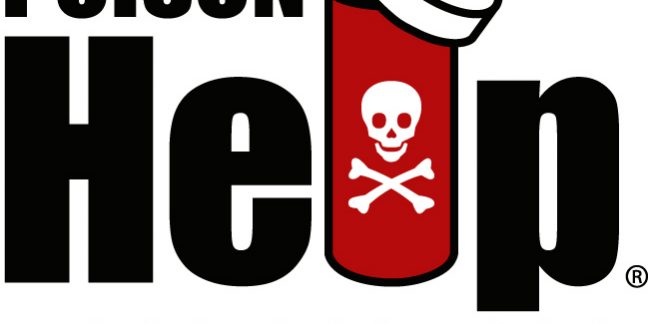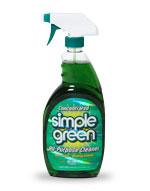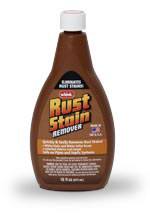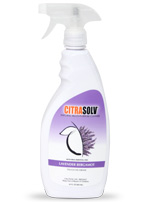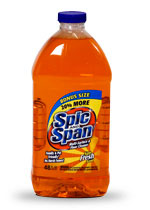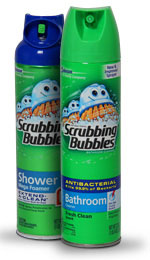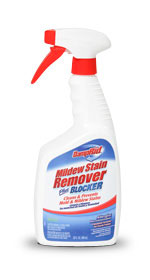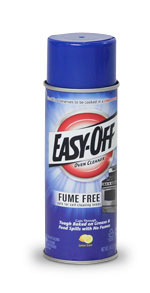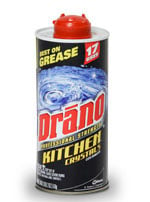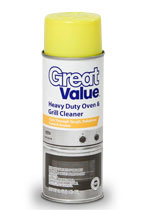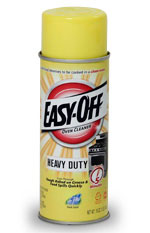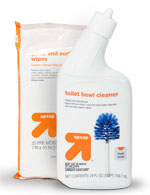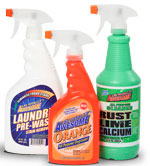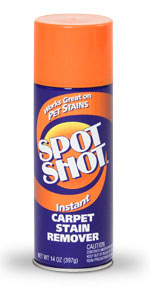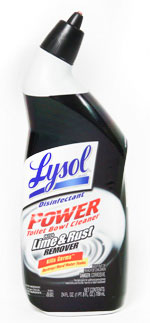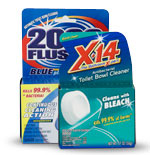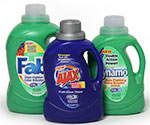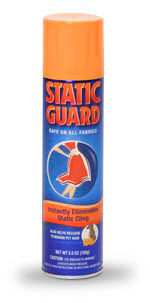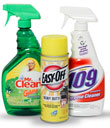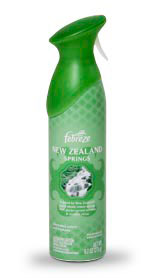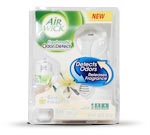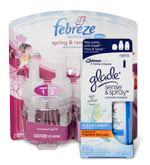EWG Cleaners Database Hall of Shame
In a ground-breaking initiative to uncover the truth about toxic chemicals in common household products, the Environmental Working Group has unearthed compelling evidence that hundreds of cleaners, even some of those hyped as “green” or “natural,” can inflict serious harm on unwary users. Many present severe risks to children who may ingest or spill them or breathe their fumes.
The first edition of the EWG Cleaners Database is due for release in fall 2012. Already, their research has turned up products loaded with extremely toxic compounds banned in some countries. Some of their ingredients are known to cause cancer, blindness, asthma and other serious conditions.
Others are greenwashed, meaning that they are not, as their ad hype claims, environmentally benign. Still more hide the facts about their formulations behind vague terms like “fragrance.” To empower consumers, the EWG Cleaners Hall of Shame, published in anticipation of the full database, highlights the worst of the worst – so far.
U.S. Green Chamber of Commerce applauds the Environmental Working Group’s efforts to educate consumers regarding toxic chemicals found in brand-name household cleaners. If a product has a childproof cap and a warning label, then you should probably think twice about exposing your home, pets, and loved ones to its caustic ingredients. EWG’s Hall of Shame serves as an excellent guide for eco-conscious consumers who prefer to buy nontoxic household cleaners that will not jeopardize our health or contaminate our ecology.
Scroll through the short list that follows and you’ll discover that our popular cleaners rarely attempt to protect our homes from harmful, even deadly, chemical ingredients. As an alternative, consumers should look to environmentally friendly cleaners that don’t carry warning labels with words like “harmful,” or “fatal.” Check out the “Green Tips” at the end of the article, where EWG offers great advice for avoiding the use of toxic chemicals in our living space.
Greenwashing
Cleaners labeled “safe,” “non-toxic” and “green” can contain hazardous ingredients. There should be a law against bogus claims, but there isn’t. Some companies are willing to bend the truth – because they can.
Simple Green Concentrated All-Purpose Cleaner
It’s labeled “non-toxic” and “biodegradable.” It contains:
- 2-butoxyethanol, a solvent absorbed through the skin that damages red blood cells and irritates eyes;
- A secret blend of alcohol ethoxylate surfactants. Some members of this chemical family are banned in the European Union.
Worse, the company website instructs the user to dilute the product significantly for even the heaviest cleaning tasks. Yet it comes in a spray bottle that implies it should be sprayed full-strength. Such use would result in higher exposures.
Whink Rust Stain Remover
Advertised for cleaning white porcelain sinks, toilet bowls and colorfast fabrics and carpet, the fine print warns:
- “May be fatal or cause permanent damage.”
- “Causes severe burns which may not be immediately painful or visible.”
- On technical information for workers, “will penetrate skin and attack underlying tissues and bone.”
- Product literature advises workers to “use only with adequate ventilation” and to wear gloves, safety goggles and a face mask. Consumers are advised only to wear rubber gloves.
Citra-Solv Cleaner & Degreaser
These concentrated liquids and ready-to-use sprays contain d-limonene and orange oils from citrus peels. According to the company’s worker safety disclosure, Citra-Solv concentrate is 85 to 95 percent d-limonene.
That the oils are derived from citrus implies safety, but sprayed into the air, they can react with trace levels of ozone air pollution to form ultra-fine particles that penetrate deep into the lungs and formaldehyde, which the U.S. government classifies as a known human carcinogen. The California Air Resources Board advises people to limit the use of citrus- or pine oil-based cleaners on smoggy days to avoid exposure to particulates and formaldehyde.
Banned abroad
Spic and Span Multi-Surface and Floor Cleaner
This product contains nonylphenol ethoxylate, which the state of California has banned in cleaning products manufactured after 2012. Products containing this chemical cannot be sold in the European Union. It breaks down to nonylphenol, which can disrupt the hormone system, is toxic to aquatic life and persists in the environment.
Scrubbing Bubbles – Antibacterial Bathroom Cleaner & Extend-A-Clean Mega Shower Foamer
These products contain up to 10 percent DEGBE, also called butoxydiglycol, a solvent banned in the European Union at concentrations above 3 percent in aerosol cleaners. It can irritate and inflame the lung.
Mop & Glo Multi-Surface Floor Cleaner
It contains DEGME, also called methoxydiglycol, at up to 15 times the concentration allowed in cleaners sold in the European Union. The United Nations Economic Commission for Europe says DEGME is “suspected of damaging the unborn child.” (This product is also sold as “Mop & Glo Triple Action Floor Shine.”)
DampRid Mildew Stain Remover Plus Blocker
It may contain up to 10 percent of a hazardous solvent called 2-butoxyethanol. Canada caps this chemical’s use in non-aerosol cleaners at 6 percent. It also contains nonylphenol ethoxylate, prohibited in cleaners sold in the E.U.
EASY-OFF Fume Free Oven Cleaner
This spray contains 5 to 10 percent DEGBE. The E.U. bars concentrations of DEGBE greater than 3 percent because it can harm the lungs.
Drain cleaners that can burn and blind
Childproof packaging is just one clue that conventional drain cleaners are extremely dangerous.
Drano Professional Strength Kitchen Crystals Clog Remover
The label says this product can severely burn eyes and skin and cause blindness or even death. Drano Kitchen Crystals may remain in the drain after use, creating an extreme hazard. Using a plunger could cause caustic splashback. Pouring any other product down the drain might trigger a dangerous chemical reaction. The label warns purchasers to “keep water out of can at all times to prevent contents from violently erupting or boiling out.” Yet unsuspecting consumers have been known to store it under the sink.
Oven cleaners that emit toxic fumes
Conventional oven cleaners can contain substantial amounts of sodium or potassium hydroxide, meant to dissolve crusty, baked-on gunk. These chemicals can also burn skin, lungs and eyes.
Walmart Great Value Heavy Duty Oven & Grill Cleaner
The label warns: “Will burn skin and eyes. Avoid contact with skin, eyes, mucous membranes and clothing. Harmful if swallowed. Avoid inhaling spray mist. Wear long rubber gloves while using…”
CVS/pharmacy Fume-Free Oven Cleaner
Though claiming to be “fume-free,” the label warns: “Vapor harmful… open windows and doors or use other means to ensure fresh air entry during application and drying.” The label says the product contains an unidentified substance “known to the state of California to cause cancer.”
EASY-OFF Heavy Duty Oven Cleaner Aerosol Spray
The label warns: “Warning: …DANGER: CORROSIVE…WILL BURN EYES AND SKIN. HARMFUL IF SWALLOWED. Avoid contact with eyes, skin, mucous membranes and clothing. DO NOT ingest. Use only with adequate ventilation. Avoid breathing spray mist. Wear long rubber gloves when using…”
Mystery mixtures
Ingredient labels are mandatory for food, cosmetics and drugs – but not for cleaners. Bowing to pressure from customers and to the threat of federal regulation, most companies list some ingredients on labels and websites or in worker safety information. But a few companies disclose nothing. Others may list one or a few ingredients or use vague terms like “surfactant” or “solvent.”
Target’s Up & Up
This brand’s Toilet Bowl Cleaner and Glass and Surface Wipes do not list any ingredients on the product packaging. Other products sold under the Up & Up label list only one or two ingredients or use vague terms.
LA’s Totally Awesome
This brand divulges few ingredients. It lists just one ingredient for its Orange All Purpose Degreaser & Spot Remover, the hazardous solvent 2-butoxyethanol.
Walmart’s Great Value
This store brand does not list ingredients in its Heavy Duty Oven & Grill Cleaner and lemon-scented Furniture Polish, despite the company’s commitment “to sell products that sustain people and the environment.” Other items sold under the Great Value brand list few ingredients or use general terms for them.
Fatal if inhaled
Some popular cleaning products contain addictive inhalants. Inhalants generally have been abused by 1 in 5 American teens and are considered “gateway drugs” that lead to drug and alcohol abuse (www.inhalent.org). They are potentially fatal in concentrated form. A few of the many inhalant products EWG found:
Glade Air Freshener Sprays, Air Wick automatic air fresheners, and Old English furniture polish
These products warn that “intentional misuse by deliberately concentrating and inhaling the contents can be harmful or fatal.”
Spot Shot Carpet Stain Remover
This product warns that “inhalation abuse of aerosol products may be harmful or fatal.”
Fatal if swallowed
When is a clean house worth this risk?
Lysol Disinfectant Power Toilet Bowl Cleaner with Lime & Rust Remover
This corrosive acid concoction kills bacteria but is also labeled “harmful or fatal if swallowed.” The cleaner’s child-proof cap is an important safety feature. The label warns not to squeeze the container when opening and to wear safety goggles. A bit of this acid in the eye can cause “irreversible damage.”
2000 Flushes and X-14 toilet bowl cleaners
These chlorine-laden discs don’t harm plumbing or septic systems, but according to the label they “may be fatal if swallowed.” The boxes warn customers to wear rubber gloves when handling, hold the disc away from the face and avoid inhaling the fumes. A pet could confuse a disc with a plastic chew toy.
High-hazard ingredients
Hagerty Liquid Jewel Clean
It contains perchloroethylene, a toxic solvent classified as “probably carcinogenic to humans” by the International Agency for Research on Cancer.
Tarn-X Tarnish Remover
This “Wipe & Rinse” product contains up to 7 percent thiourea, a chemical classified as a carcinogen by the state of California. The company’s technical information for workers says “prolonged or repeated exposure may cause reproductive and fetal effects.”
Ajax, Dynamo and Fab Ultra liquid laundry detergents (Phoenix Brands)
These contain formaldehyde, also known as formalin, classified as a known human carcinogen by the U.S. government and World Health Organization. Formaldehyde can cause asthma and allergies. The company divulges the presence of formaldehyde in the product only on technical disclosures for workers.
Combatting static with toxic chemicals
Dryer sheets and anti-static sprays may free clinging fabrics and stop static sparks, but they usually do it with quaternary ammonium compounds that can irritate lungs and cause asthma as well as allergic contact dermatitis.
Static Guard
This product contains the chemical DTDMAC, or ditallow dimethyl ammonium chloride, which is so persistent in the environment that it can’t be used as a cleaning ingredient in the European Union.
Final Touch Ultra Liquid Fabric Softener
This brand contains quaternium-18 (dihydrogenated tallow dimethyl ammonium chloride or DHTDMAC), which also cannot be used in cleaning products sold in the European Union because of its persistence in the environment.
Spray cleaners with asthma-causing ingredients
Even though 1 in 10 U.S. children suffers from asthma, some companies make spray cleaners that fill the air with asthmagens, meaning ingredients that cause asthma.
Clorox, Fantastik, Febreze, Formula 409, Easy-Off, Lysol, Mr. Clean and Spic and Span.
Many of the spray cleaners sold under these brand names are laced with quaternary ammonium compounds or ethanolamine, ingredients classified as asthmagens by the Association of Occupational and Environmental Clinics, a professional association of clinics and health experts. These chemicals can trigger asthma attacks and can cause new cases of the disease in people who are asthma-free. Ingredients classified as asthmagens don’t belong in spray products.
100+ hidden chemicals
EWG’s 2009 state-of-the-art air pollution tests of 21 common school cleaning products turned up a wide range of air contaminants linked to asthma, cancer, reproductive toxicity, hormone disruption and neurotoxicity. Some of the worst offenders are in products also commonly used in the home.
Undisclosed chemicals in the air
Air fresheners do not clean or purify the air. They merely cover up odors by releasing undisclosed mixtures of fragrance chemicals. Common fragrance components include chemicals that spur allergies, trigger asthma attacks or impair reproduction.
Lysol Neutra Air Freshmatic
This product boasts that “your home will always smell fresh and clean” but cautions that the device should be placed “in well-ventilated rooms away from sleeping areas.” Among the label’s warnings: may be harmful if directly inhaled, may cause allergic reaction in some individuals, DO NOT spray towards face or body, DO NOT get in eyes, avoid content with skin, DO NOT spray directly onto surfaces.
Air Wick Freshmatic Compact
This product cautions to “use in well-ventilated rooms away from sleeping areas.”
Febreze and Glade automatic air fresheners
These products warn, “Do not use in small confined pet areas without adequate ventilation.”
Dead zone detergents
Most detergents claim they are “phosphate free.” And that’s a good thing, because phosphate compounds, formerly a mainstay for cleaning dishes and clothing, wash into waterways and spur rampant algae growth that leads to massive “Dead Zones” in the Gulf of Mexico, Chesapeake Bay and other water bodies.
Twenty-five states and the District of Columbia prohibit phosphates in household dishwashing and laundry detergents. But some companies exploit a legal loophole by selling phosphate-laden additives that are as harmful as banned detergents.
FINISH Glass Magic Hardwater Performance Booster
This product contains up to 21 percent phosphate by weight, according to the label.
EWG offers the following Green Tips for folks who wish buy nontoxic cleaning products.
- Read labels carefully and pay special attention to warnings. Don’t buy any products labeled “poison,” “danger” or “fatal” if swallowed or inhaled.
- Check your brands’ labels and websites for ingredient lists. Avoid products containing nonylphenol ethoxylates (look for “nonylphen” or “nonoxynol” within the ingredient name) and 2-butoxyethanol, butoxydiglycol, ethylene- or diethylene glycol monobutyl ether, diethylene glycol monomethyl ether or methoxydiglycol.
- Whenever possible, use a drain snake and plunger instead of chemical drain cleaners. Store drain cleaner in high secure cabinets out of reach of children and away from water.
- As an alternative to caustic oven cleaners, sprinkle baking soda liberally to cover the bottom of the oven. Spray with water. Wait 8 hours, scrape and wipe clean.
- Look for products listing most or all ingredients on the label or website. No information could mean something to hide.
- Talk to your kids about the risks of inhalants (www.inhalant.org). Read warning labels and keep cleaners that are potentially fatal if inhaled out of your home.
Do you know of any nontoxic home recipes for environmentally friendly household cleaners?
Related articles
- The Problem with the Smell of Clean (granolacatholic.blogspot.com)
- 12 Household Cleaning Ingredients to Avoid (usgreenbrokers.com)
- Beware: Most Green Cleaning Products Contain This (articles.mercola.com)
- About
- Programs
- Advocacy
- Membership
- Chapters
- Global
- Sustainability
- Contact
- Institute
- About
- Programs
- Advocacy
- Membership
- Chapters
- Global
- Sustainability
- Contact
- Institute

